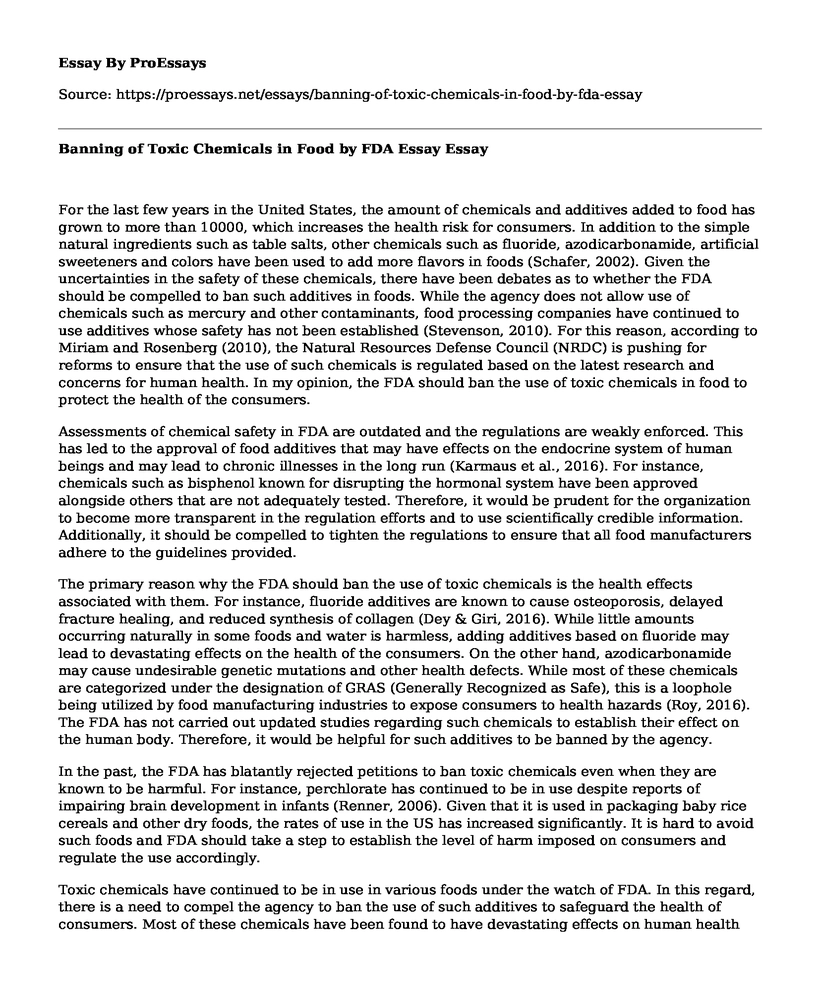For the last few years in the United States, the amount of chemicals and additives added to food has grown to more than 10000, which increases the health risk for consumers. In addition to the simple natural ingredients such as table salts, other chemicals such as fluoride, azodicarbonamide, artificial sweeteners and colors have been used to add more flavors in foods (Schafer, 2002). Given the uncertainties in the safety of these chemicals, there have been debates as to whether the FDA should be compelled to ban such additives in foods. While the agency does not allow use of chemicals such as mercury and other contaminants, food processing companies have continued to use additives whose safety has not been established (Stevenson, 2010). For this reason, according to Miriam and Rosenberg (2010), the Natural Resources Defense Council (NRDC) is pushing for reforms to ensure that the use of such chemicals is regulated based on the latest research and concerns for human health. In my opinion, the FDA should ban the use of toxic chemicals in food to protect the health of the consumers.
Assessments of chemical safety in FDA are outdated and the regulations are weakly enforced. This has led to the approval of food additives that may have effects on the endocrine system of human beings and may lead to chronic illnesses in the long run (Karmaus et al., 2016). For instance, chemicals such as bisphenol known for disrupting the hormonal system have been approved alongside others that are not adequately tested. Therefore, it would be prudent for the organization to become more transparent in the regulation efforts and to use scientifically credible information. Additionally, it should be compelled to tighten the regulations to ensure that all food manufacturers adhere to the guidelines provided.
The primary reason why the FDA should ban the use of toxic chemicals is the health effects associated with them. For instance, fluoride additives are known to cause osteoporosis, delayed fracture healing, and reduced synthesis of collagen (Dey & Giri, 2016). While little amounts occurring naturally in some foods and water is harmless, adding additives based on fluoride may lead to devastating effects on the health of the consumers. On the other hand, azodicarbonamide may cause undesirable genetic mutations and other health defects. While most of these chemicals are categorized under the designation of GRAS (Generally Recognized as Safe), this is a loophole being utilized by food manufacturing industries to expose consumers to health hazards (Roy, 2016). The FDA has not carried out updated studies regarding such chemicals to establish their effect on the human body. Therefore, it would be helpful for such additives to be banned by the agency.
In the past, the FDA has blatantly rejected petitions to ban toxic chemicals even when they are known to be harmful. For instance, perchlorate has continued to be in use despite reports of impairing brain development in infants (Renner, 2006). Given that it is used in packaging baby rice cereals and other dry foods, the rates of use in the US has increased significantly. It is hard to avoid such foods and FDA should take a step to establish the level of harm imposed on consumers and regulate the use accordingly.
Toxic chemicals have continued to be in use in various foods under the watch of FDA. In this regard, there is a need to compel the agency to ban the use of such additives to safeguard the health of consumers. Most of these chemicals have been found to have devastating effects on human health and their continued use is a risk to health. Therefore, FDA should the use of these chemicals in foods.
References
Dey, S., & Giri, B. (2016). Fluoride Fact on Human Health and Health Problems: A Review. Medical & Clinical Reviews, 02(01). http://dx.doi.org/10.21767/2471-299x.1000011
Karmaus, A., Filer, D., Martin, M., & Houck, K. (2016). Evaluation of food-relevant chemicals in the ToxCast high-throughput screening program. Food And Chemical Toxicology, 92, 188-196. http://dx.doi.org/10.1016/j.fct.2016.04.012
Miriam, R., & Rosenberg, D. (2010). Get Risky Chemicals Out of Food. NRDC. Retrieved 18 April 2018, from https://www.nrdc.org/issues/get-risky-chemicals-out-food
Renner, R. (2006). Reproductive Toxicity: New Take on Perchlorate Effects. Environmental Health Perspectives, 114(11), A637-A637. http://dx.doi.org/10.1289/ehp.114-a637a
Roy, K. (2016). Safer Science: Safer Use of Toxic Chemicals. The Science Teacher, 083(03). http://dx.doi.org/10.2505/4/tst16_083_03_79
Schafer, K. (2002). Persistent toxic chemicals in the US food supply. Journal Of Epidemiology & Community Health, 56(11), 813-817. http://dx.doi.org/10.1136/jech.56.11.813
Stevenson, J. (2010). Recent Research on Food Additives: Implications for CAMH. Child And Adolescent Mental Health, 15(3), 130-133. http://dx.doi.org/10.1111/j.1475-3588.2010.00563.x
Cite this page
Banning of Toxic Chemicals in Food by FDA Essay. (2022, May 15). Retrieved from https://proessays.net/essays/banning-of-toxic-chemicals-in-food-by-fda-essay
If you are the original author of this essay and no longer wish to have it published on the ProEssays website, please click below to request its removal:
- Analysis of San Diego in the 1930s
- Thermodynamics Fundamentals Paper Example
- Essay Sample on Life on Mars
- Article Analysis Essay on Don't Blame the Eater
- Essay on Community Health Education Plan: Reduce Sugar Consumption & Enhance Healthy Eating
- Chemical Risks in Nursing: Navigating Hazards for Oncology Nurses - Essay Sample
- Essay Example on Geography: Location, Place, and Region Explored







